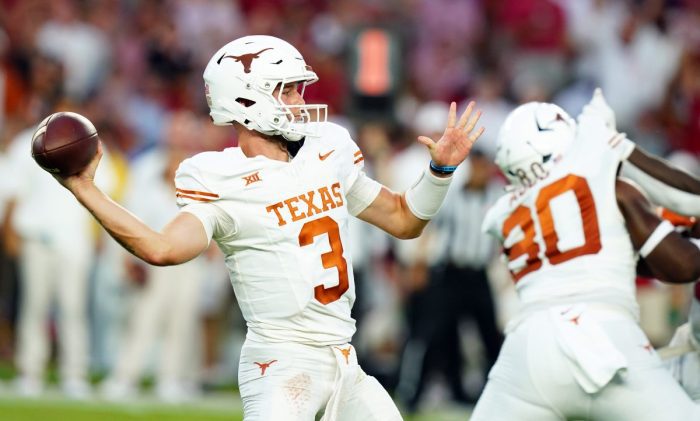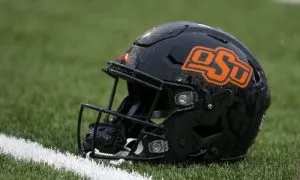Texas vs. Oregon: Comparing College Football Playoff Resumes

For the fifth time this season, Tuesday night was the setting for the College Football Playoff Rankings Show on ESPN, and for the fifth consecutive weekend, the Texas Longhorns found themselves at No. 7 on the list.
Despite the order changing (sparingly) ahead head of them, the same six teams have always found themselves ahead of the Longhorns and this is what the top six look like after the regular season:
- Georgia (12-0)
- Michigan (12-0)
- Washington (12-0)
- Florida State (12-0)
- Oregon (11-1)
- Ohio State (11-1)
Now, for the teams ranked 1-4, I have no problem with them being ranked ahead of the Longhorns if for nothing else but they’re undefeated. Going 12-0 through a regular season in any Power Five conference is exceedingly difficult, and for that, those teams should be rewarded.
However, under what circumstances do the Oregon Ducks or Ohio State Buckeyes deserve to be ranked ahead of Texas? Did one of those teams do something that I’ve missed? As I sat and listened to Boo Corrigan stumble through his explanation of why the Ducks deserved to be ahead of the Longhorns, I quickly realized that the folks in charge of crowning our sport’s national champion don’t even believe in the process they are supposedly upholding.
According to the College Football Playoff website, the CFP selection committee will “select the teams using a process that distinguishes among otherwise comparable teams by considering” the following:
- Conference championships won,
- Strength of schedule,
- Head-to-head competition,
- Comparative outcomes of common opponents (with incenting margin of victory), and,
- Other relevant factors such as unavailability of key players and coaches that may have affected a team’s performance during the season or likely will affect its postseason performance.
After reviewing the principles used to select teams, I started to wonder what exactly goes on behind closed doors in the meetings before the CFP Top 25 comes out each week. Because, if those were the factors being weighed to rank the teams, things would look much differently.
So, naturally, I took a deep dive into the resumes for each of the eight teams that remain in the Playoff hunt.
| METRICS | (Team1) | (Team2) | (Team3) | (Team4) | (Team5) | (Team6) | (Team7) | (Team8) |
|---|---|---|---|---|---|---|---|---|
| RECORD | 11-1 | 12-0 | 12-0 | 12-0 | 11-1 | 11-1 | 11-1 | 12-0 |
| W/L vs. Top 25 | 3-1 | 2-0 | 3-0 | 2-0 | 2-1 | 1-1 | 2-1 | 2-0 |
| SOS | 31 | 56 | 59 | 36 | 6 | 62 | 13 | 46 |
| SOR | 7 | 3 | 4 | 1 | 5 | 9 | 6 | 2 |
| FPI | 6 | 9 | 5 | 2 | 1 | 3 | 7 | 13 |
| GAME CONTROL | 9 | 15 | 5 | 1 | 4 | 3 | 2 | 6 |
| W/L vs. Contenders | 0-1 | 0-0 | 0-0 | 1-0 | 0-1 | 0-1 | 1-0 | 1-0 |
When looking at these teams, is there a clear group of four that should move on to the College Football Playoff? Sure, there are four teams sitting at 12-0, but those four teams have three of the four easiest schedules of the group. Meanwhile, Team 5 and Team 7 have played very difficult schedules, but have losses to show for it. It’s a bit hard to narrow the list down this way, so let’s try another route.
What if we were to compare only the one-loss teams?
| METRICS | (Team 1) | (Team 5) | (Team 6) | (Team 7) |
|---|---|---|---|---|
| RECORD | 11-1 | 11-1 | 11-1 | 11-1 |
| W/L vs. Top 25 | 3-1 | 2-1 | 1-1 | 2-1 |
| SOS | 31 | 6 | 62 | 13 |
| SOR | 7 | 5 | 9 | 6 |
| FPI | 6 | 1 | 3 | 7 |
| GAME CONTROL | 9 | 4 | 3 | 2 |
| W/L vs. Contenders | 0-1 | 0-1 | 0-1 | 1-0 |
When looking at the teams with one loss, there are two things that jump out right away. First, Team 6 has played the easiest schedule of the group by a wide margin and is .500 against ranked teams. Second, Team 7 is the only team to have a win against the other CFP contenders, at least among the group of 11-1 teams.
So, if we ranked these teams based on the resumes alone, how would things look? Perhaps something like this?
- Team 7
- Team 5
- Team 1
- Team 6
Now, this is where things get speculatory, but let’s simulate Championship Weekend.
- 5 Oregon def. 3 Washington, 36-28
- 7 Texas def. 18 Oklahoma State, 38-14
- 1 Georgia def. 8 Alabama, 27-20
- 2 Michigan def. 16 Iowa, 27-3
- 4 Florida State def. 14 Louisville, 27-24
That leaves us with three undefeated Power Five champions, No. 1 Georgia, No. 2 Michigan, and No. 4 Florida State. I would expect those three teams to make the field as the top three seeds in the Playoff, but what about the last spot? Who deserves to be the No. 4 team in the playoff?
Here are the candidates:
- Oregon (12-1): Pac-12 Champion
- Texas (12-1): Big 12 Champion
- Washington (12-1): Pac-12 Runner Up
- Ohio State (11-1): At-Large
The committee would likely eliminate Washington and Ohio State in this scenario, as neither team secured a conference championship. That leaves Texas and Oregon as the final two teams vying for a playoff spot. So, who deserves to get in? Let’s look at their updated resumes side-by-side.
| METRICS | (Team 6) | (Team 7) |
|---|---|---|
| RECORD | 12-1 | 12-1 |
| W/L vs. Top 25 | 2-1 | 3-1 |
| SOS | 62 | 13 |
| SOR | 9 | 6 |
| FPI | 3 | 7 |
| GAME CONTROL | 3 | 2 |
| W/L vs. Contenders | 1-1 | 1-0 |
Both teams sit at 12-1 with a conference championship, but one team played a significantly more difficult schedule and had one more win against Top 25 opponents. So, in this scenario, it’s clear that Team 7 is more deserving of the final spot. Well, that team isn’t Oregon. It’s Texas.
So, after seeing the resumes side-by-side, tell me how this explanation makes any sense.
Do you want the short answer? It doesn’t.
The total lack of explanation, and awareness for that matter, from the CFP committee chair, is concerning. Corrigan pointed to Oregon continuing to be “dominant,” yet Texas edges out the Ducks in game control, ranking second nationally. Does the committee believe the Pac-12 is objectively better than the Big 12 this season?
Both conferences have four team ranked in the latest Top 25, and while Washington and Oregon are both ranked higher than Texas and the second-highest ranked Big 12 team, Oklahoma (No. 12), the Longhorns and Sooners would both be favored over the Huskies on a neutral field.
If the committee believes the Pac-12 is a tougher league, then show that in the rankings. Don’t make the conferences comparable with the same number of ranked teams and then say that Oregon’s resume is better, when it clearly isn’t.
Texas’ loss to No. 12 Oklahoma is comparable to Oregon’s loss to No. 3 Washington, and the Longhorns’ resume is objectively better than the Ducks’. However, if you want a direct comparison between these two teams, you’re in luck because they’ve got a common opponent.
Both the Ducks and Longhorns played Texas Tech this season. Oregon went to Lubbock and picked up a 38-30 win over the Red Raiders, but needed a 20-point fourth quarter to do so after trailing 27-18 entering the final frame. Meanwhile, Texas hosted the Red Raiders to close out their season and won 57-7. Texas isn’t getting credit for the margin of victory over a common opponent, even though that is a defined criteria the CFP committee is supposed to use to rank teams.
If the final spot comes down to Texas or Oregon, the Longhorns are the more deserving team, and that is backed up by the numbers.
***Here are the corresponding teams in table: Alabama (1), Florida State (2), Georgia (3), Michigan (4), Ohio State (5), Oregon (6), Texas (7), Washington (8)
























